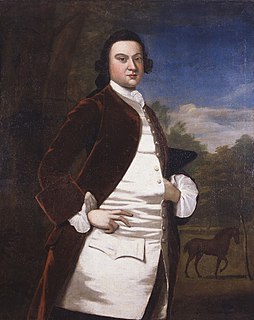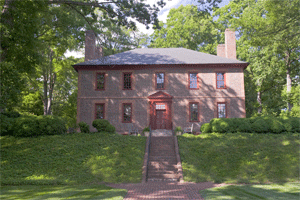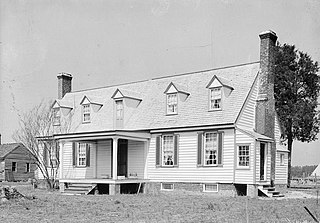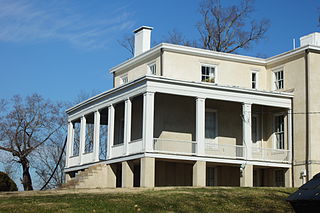Related Research Articles

Westover Plantation is a historic colonial tidewater plantation located on the north bank of the James River in Charles City County, Virginia. Established in c. 1730–1750, it is the homestead of the Byrd family of Virginia. State Route 5, a scenic byway, runs east–west to the north of the plantation, connecting the independent cities of Richmond and Williamsburg.

Evelynton Plantation is an estate located on the north bank of the James River in Charles City County, Virginia. It is located along State Route 5, a scenic byway which runs between the independent cities of Richmond and Williamsburg. Evelynton is listed on the National Register of Historic Places.

Mary Willing Byrd was an American planter.

William Byrd III was the son of William Byrd II and the grandson of William Byrd I. He inherited his family's estate of approximately 179,000 acres of land in Virginia and continued their planter prestige as a member of the Virginia House of Burgesses.
A plantation house is the main house of a plantation, often a substantial farmhouse, which often serves as a symbol for the plantation as a whole. Plantation houses in the Southern United States and in other areas are known as quite grand and expensive architectural works today, though most were more utilitarian, working farmhouses.

Wilton House Museum is a museum in a historic house located in Richmond, Virginia. Wilton was constructed c. 1753 by William Randolph III, son of William Randolph II, of Turkey Island. Wilton was originally the manor house on a 2,000-acre (8.1 km2) tobacco plantation located on the north bank of the James River several miles east of the city of Richmond. Between 1747 and 1759, William III acquired more than a dozen contiguous tracts of land. About 1753, Randolph completed building a Georgian manor house, which he named "Wilton," on a site overlooking the river.

Rosewell Plantation in Gloucester County, Virginia, was for more than 100 years the home of a branch of the Page family, one of the First Families of Virginia. Begun in 1725, the Flemish bond brick Rosewell mansion overlooking the York River was one of the most elaborate homes in the American colonies.

Mount Airy, near Warsaw in Richmond County, Virginia, built in 1764, is a mid-Georgian plantation house, the first built in the manner of a neo-Palladian villa. Colonel John Tayloe II, perhaps the richest Virginia planter of his generation, constructed it. His daughter Rebecca and her husband, Francis Lightfoot Lee, one of the only pair of brothers to sign the Declaration of Independence are buried on the estate, as are many other Tayloes. Before the American Civil War, Mount Airy was a prominent racing horse farm, as well as headquarters of about 10-12 separate slave plantations along the Rappahannock River. Mount Airy is listed on the National Register of Historic Places as a National Historic Landmark as well as on the Virginia Landmarks Register, and is still privately owned by Tayloe's descendants.

Piney Grove at Southall's Plantation is a property listed on the National Register of Historic Places in Holdcroft, Charles City County, Virginia. The scale and character of the collection of domestic architecture at this site recalls the vernacular architectural traditions of the eighteenth, nineteenth and twentieth centuries along the James River.

Faunsdale Plantation is a historic plantation near the town of Faunsdale, Alabama, United States. The town was named for it, in honor of a late owner. This plantation is in the Black Belt, which was developed for cotton plantations. During the antebellum period, planters held as many as 186 enslaved African Americans at this property as laborers to raise cotton as a commodity crop.

Bremo, also known as Bremo Plantation or Bremo Historic District, is a plantation estate covering over 1,500 acres (610 ha) on the west side of Bremo Bluff in Fluvanna County, Virginia. The plantation includes three separate estates, all created in the 19th century by the planter, soldier, and reformer John Hartwell Cocke on his family's 1725 land grant. The large neo-palladian mansion at "Upper" Bremo was designed by Cocke in consultation with John Neilson, a master joiner for Thomas Jefferson's Monticello. The Historic District also includes two smaller residences known as Lower Bremo and Bremo Recess.

The Clover Hill Tavern with its guest house and slave quarters are structures within the Appomattox Court House National Historical Park. They were registered in the National Park Service's database of Official Structures on October 15, 1966.

Greenway Plantation is a wood-frame, 1 1/2-story plantation house in Charles City County, Virginia. Route 5, an east-west road, passes to the south of this property. Located just west of the county seat Charles City Courthouse, Virginia, Greenway is one of Charles City's earliest and most distinctive Colonial plantations. It was added to the National Register of Historic Places in 1969.

Richmond Hill is an ecumenical fellowship, residence and urban retreat center. The St. John's Church Historic District in Richmond, Virginia includes several churches of various denominations, including this former Catholic convent and school which is a contributing property that continues to address the area's spiritual and educational needs.

Dogham Farm, previously known as Doggams, is a historic home and farm located near Charles City, Charles City County, Virginia. In 1642, Joseph Royall patented 600 acres on the north side of the James River in Charles City County. The plantation he named "Doggams" later became known as "Dogham" in the 18th century. Following the death of Joseph Royall, his widow married Henry Isham. The property remains in the Royall and Isham lines today.

Elk Hill, also known as Harrison's Elk Hill, is a historic plantation home located near Goochland, Goochland County, Virginia. It was built between 1835 and 1839, and is a 2 1/2-story, three-bay, stuccoed brick central-hall-plan house in the Greek Revival style. It has a two-story rear ell. The front facade features a one-story Tuscan order portico consisting of paired rectangular wooden pillars supporting a full entablature. Also on the property are the contributing servants' quarters, tack house, and spring house. It was listed on the National Register of Historic Places in 1979.

Laurel Meadow is an historic house at 1640 Bramwell Road in Richmond, Virginia. The oldest portion of this wood frame house was built prior to 1776, when the property was acquired by David Patteson. Patteson, who had been a steward of the Westover Plantation of William Byrd III, was an officer in the Revolutionary War, a Colonel in the Virginia Militia, a member of the House of Delegates, and represented Chesterfield County at the Virginia Constitutional Ratification Convention of 1788. He voted to ratify the Constitution. The building has three portions, forming an L shape. The oldest portion is the Northwest wing, which is 1.5 stories and now houses a library and stair hall below and a sitting room above, which was probably at first a bedroom. A dining room and upper bedchamber were believed to have been added by Patteson. A third wing including a lower passage and parlor below and an upper passage and bedchamber above, was added to the Northeast section early in the 19th century, and the building was significantly restyled, giving it a Federal interior. The house is one of only a small number of colonial-era houses in the Richmond area.

The planter class, known alternatively in the United States as the Southern aristocracy, was a socio-economic caste of Pan-American society that dominated 17th and 18th century agricultural markets through the slavery of African Americans. The Atlantic slave trade permitted planters access to inexpensive labor for the planting and harvesting of crops such as tobacco, cotton, indigo, coffee, tea, cocoa, sugar cane, sisal, oil seeds, oil palms, hemp, rubber trees, and fruits. Planters were considered part of the American gentry.
References
- ↑ "Patteson-Schutte House,5613 Kildare Drive". Historic Richmond. Retrieved 9 October 2015.
- ↑ Katie Kelley, Architectural Historian, Historic Richmond Foundation